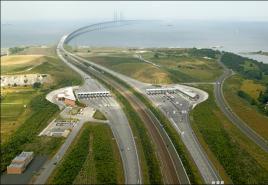How long is the bridge between Denmark and Sweden. Oresund bridge - connection between sweden and denmark
As you know, nature is the best artist and magician. She creates such landscapes and amazing places that are often hard to imagine. But, lately, the man is not far behind. In between attempts to offend our planet as much as possible and pollute it as much as possible, humanity still creates interesting things worthy of attention and inclusion in the list of world attractions.
A striking example of such creative activity is the unique Øresund Bridge. It connects Sweden and Denmark via the Øresund Strait.
There are a huge number of bridges on our planet that attract the eye. The Hero's Glass Bridge in China, the Bastei Bridge in Switzerland or the unusual Magdeburg Water Bridge in Germany. These are just a few of the amazing bridges. So what is remarkable about the Øresund Bridge? Yes, the fact that approximately in the middle it visually breaks off and goes ... underground, or rather under water.
The bridge connects the city of Malmö in Sweden and the Danish capital Copenhagen.
Øresund Bridge on the map
- The geographical coordinates of its middle are 55.591954, 12.769471
- The distance from the capital of Denmark is 0 km, since the bridge-tunnel starts directly from Copenhagen
- The distance from the Swedish capital Stockholm is about 530 km in a straight line
- The nearest airport Kastrup (in Copenhagen) is literally within walking distance from the beginning of the tunnel bridge
Ferry service between Sweden and Denmark has been established for a long time. But it was also necessary to lay a land road. The idea to connect the Scandinavian peninsula with mainland Europe by road and rail appeared long ago. Back in 1936, the need to build a bridge was expressed. But such a large-scale project began to be implemented only in 1995.
A lot of geological, technical, financial and other studies were carried out. During them, it became clear that the large island of Saltholm (translated as the island of Salt), which lies almost in the middle of the strait, is not suitable for the base of the bridge. It was decided to lay the surface part of the bridge from the Swedish city of Malmö at a distance of just under 8 kilometers.
 Here begins the Øresund Bridge on the Swedish side
Here begins the Øresund Bridge on the Swedish side Further, the road should go about 3.7 kilometers along an artificial island, poured one and a half kilometers south of the island of Saltholm and dive underground into a tunnel 4 kilometers long. This tunnel ends and all the way in the eastern part of Copenhagen near Kastrup Airport.
The presence of an airport in this place was a decisive factor in the construction of a tunnel under water, and not a traditional bridge. The fact is that for the passage of ships under the bridge, in any case, large spans and high pylons will be required. And this can create obstacles for aircraft coming in for landing.
The project was approved. October 18, 1995 is considered the official start of construction.
According to the project, the bridge has 2 railway lines on the lower level, and 4 car lanes on the upper level.
 The railroad is under the road
The railroad is under the road The height of the above-water part gradually increases towards its middle, and gradually decreases towards the artificial island. In the middle part rise pylons 204 meters high, and between them a span 490 meters long. This ensures unhindered passage of ships, although it should be noted that captains prefer to navigate their ships not here, but over the underwater part of the Øresund bridge.
 These are pylons with a height of 204 meters and a span of 490 meters between them
These are pylons with a height of 204 meters and a span of 490 meters between them Next, an artificial island was poured, about 4 kilometers long and no more than 460 meters wide. The Danes named the island Peberholm (which means Pepper Island). It really does look like a pepper. But there is another interesting feature in the title. Usually in cafes and restaurants on the tables nearby are salt and pepper. So in the strait there is “Salt” (Saltholm Island), but there is no “Pepper”. The Danes corrected this misunderstanding by naming the artificial island "Pepper" (respectively, Peberholm). This island stretches in the strait from east to west. Its western part is the beginning of the underwater tunnel. It is there that trains and cars “disappear” in order to “emerge” after 4 kilometers on the Danish side.
 In this place, cars and trains disappear “without a trace” in order to solemnly appear from under the ground in Denmark after 4 kilometers
In this place, cars and trains disappear “without a trace” in order to solemnly appear from under the ground in Denmark after 4 kilometers The underwater tunnel, named Drogden, is no less colossal structure than the surface part of the bridge. It was created from 20 individual reinforced concrete sections, each weighing 55,000 tons. They were collected together already at the bottom of a specially dug channel in the strait. The tunnel consists of 5 channels. Two for rail transport, two for road transport and one spare, emergency passage in case of emergency.
 Scheme of the Drogden tunnels under the Øresun Strait
Scheme of the Drogden tunnels under the Øresun Strait On the artificial island of Peperholm, a helipad is also provided in case of an emergency.
Construction came to an end in mid-August 1999. Prince Frederik of Denmark and Princess Victoria of Sweden met in the middle of the bridge on 14 August, marking the end of construction. But the bridge was not yet accessible to the general public. The bridge was officially opened by the monarchs of Denmark (Queen Margaret II) and Sweden (King Carl Gustav 16th) on July 1, 2000. And from the same day traffic was allowed.

Øresund Bridge in numbers
- The total length of the road connecting the two countries is 15.9 kilometers
- The length of the above-water part of the bridge is 7,845 meters
- The surface part of the bridge weighs 82,000 tons
- The length of the tunnel under water is 4 kilometers
- The remaining kilometers of the route pass along the artificial island of Peberholm
- The average height of the bridge above the sea is 57 meters
- The maximum height of the two pylons built when creating the arch for the passage of ships reaches 204 meters (meaning the total height of the structure, not the height of the roadway)
- Bridge width - 23.5 meters
There is a narrower part of the strait 50 kilometers north of the bridge. Here, on opposite banks, there are cities with similar names, Helsingør (from the Danish side) and Helsingborg (from the Swedish side). Cities (and at the same time countries) in this place are connected by a ferry crossing. The width of the strait here is only 4.7 kilometers, but the designers of the Øresund Bridge did not build it here, but chose a wider, but less dangerous part of the strait. In favor of this decision can be attributed to the difference in depth, 41 meters in the northern part of the strait versus 10 meters in the south.

The cost of building the Øresund Bridge is estimated at around 4 billion euros. The passage on the bridge is paid and not quite cheap. Traveling by car costs about 50 euros, and for long vehicles it even reaches 200 euros. But even at such prices, the project will pay for itself at best by 2030. In addition, a flexible system of discounts is provided for customers crossing the border along this bridge. If you often travel along this route, you can save up to 75% of the fare.
There were plans to add a bike path at a cost of 210 million euros, but this idea was subsequently abandoned. As a result, there are no bicycle or pedestrian paths on the bridge.
Local residents have long been accustomed to the bridge, but for tourists it will be very interesting. It's not every day you see a bridge to nowhere.

Oresund bridge photo
 The surface part of the Øresund bridge
The surface part of the Øresund bridge 
 And here begins the tunnel under the strait
And here begins the tunnel under the strait 

Recently, Danish Copenhagen and Swedish Malmö are connected by a unique road-railway bridge-tunnel.
The construction of the Øresund bridge-tunnel began in 1995 and was completed on August 14, 1999. Despite the fact that a couple of important incidents prevented the construction - the discovery of 18 unexploded shells from the Second World War at the bottom of the sea and the warping of one of the segments of the tunnel - the bridge was completed 3 months earlier than planned

The completion of construction was marked by a symbolic meeting between the Danish Prince Frederik and the Swedish Crown Princess Victoria in the middle of the bridge. The official opening took place on July 1, 2000, already with the participation of the monarchs themselves - Queen Margrethe II, and King Carl XVI Gustaf

The appearance of the project of such an unusual structure was facilitated by the fact that Denmark and Sweden are included in the Schengen zone and passport control was canceled between them and customs control was simplified

Initially, the bridge was very expensive to cross - in an attempt to recoup its unprecedented cost, the government charged too high a price - so it was used by a few, but subsequently, in 2005-2006, traffic increased significantly. Analysts attribute this to the fact that many Danes bought houses in Malmö, Sweden, which were inexpensive by the standards of Danish salaries, and traveled to work in Denmark along the Øresund bridge. In this regard, discounts of up to 75% of the fare were introduced for people who regularly cross it.

In 2008, a road trip across the bridge cost €36.3 (260 Danish or 325 SEK). In 2007, almost 25 million people crossed the bridge, of which more than 15 million - on their own vehicles and almost 10 million - on trains

The Øresund Bridge includes a double-track railway and a four-lane motorway. Its total length is 7845 meters, every 140 of which the bearing beam of the bridge rests on concrete pillars. The main span has a height of 57 meters, which allows most ships to safely pass under it, although many prefer a calm passage over the tunnel itself, with which the bridge connects on an artificial island, nicknamed Peberholm (Pepper Island) for its shape


By inertia, the Danes, with their inherent sense of humor, decided to give a new name to the natural island located just to the north, which is now called nothing more than Saltholm (Island-Salt). Peberholm Island is 4 kilometers long and 500 meters wide on average. The building material for it was rock fragments and tons of rock raised from the bottom during dredging during the construction of the bridge.

The island of Peberholm is connected to the Danish artificial peninsula Kastrup on the island of Amager by the 4-kilometer Drogden Tunnel. More precisely, its length is 4050 meters, which includes 270 meters of portals at both exits and 3510 meters of flat underwater part.

During the construction of the tunnel to the bottom of the strait, 20 reinforced concrete segments of 55 thousand tons each were lowered into a specially dug channel, which were then combined into one. In total, 5 pipes pass through the Drogden tunnel - two each for rail and road traffic, and a fifth, smaller pipe for emergencies

Why was such a strange half-bridge-half-tunnel built across the strait? Why did the government of the two countries go to the additional expense and complexity associated with the construction of the tunnel? The reason lies in the proximity of the Copenhagen airport (an ordinary bridge would prevent aircraft from taking off and landing), plus this design made it possible not to restrict shipping traffic through the Öresund

In total, more than 30 billion Danish kroner (based on the exchange rate of the Danish krone in 2000) was spent on the construction of the Øresund bridge-tunnel - an amount that will pay off only by 2035. In addition, in order to expand the railway interchange coming from the bridge, in 2006 the Swedish side spent another 9.45 billion SEK on the city tunnel in Malmö, the construction of which was completed in 2011

In 2010, a road trip across the bridge cost 39 euros, a motorcycle ride 21 euros, and a train ride 9 euros. But the fee is gradually growing - today, in order to drive through the Øresund bridge-tunnel by car, you will have to pay 43 euros

The small Swedish town of Malmö is known to many thanks to an amazing skyscraper.

The onset of the age of high technology has slightly diverted the attention of tourists from the ancient monuments of architecture. Increasingly, masterpieces of modern engineering are becoming the subject of delight and admiration. It is to them that the unique building of the end of the last millennium belongs - the tunnel connecting Copenhagen and Malmö.
Øresund Bridge: construction of an underwater bridge
Construction began in 1995. The project was a bridge between the Danish capital Copenhagen and the Swedish town of Malmö.
Having already begun to implement the plan, the workers discovered a terrible secret of the depths of the Baltic Sea: 18 charges from the Second World War were discovered at the bottom of the Øresund Strait. In addition, an engineer's mistake led to the distortion of one of the parts of the bridge.
It is inferior in length in Lisbon, but no less interesting. 
Despite all the difficulties that arose, the project was completed even ahead of schedule. The last work was carried out on August 14, 1999.
Princess Victoria of Sweden and Danish Prince Frederik met in the middle of the bridge almost immediately after its completion, cementing the friendship between the countries. The monarchs themselves - Queen Margrethe II and King Carl XVI Gustav - visited the building only a year later, and, thereby, appointed July 1, 2000 as the day of the official opening of the Øresund Bridge.

Unique Øresund bridge-tunnel
In fact, it does not reach the coast of Denmark. In order not to complicate the work of the Danish airport and to allow ships to move freely along the strait, the construction ends on the artificial island of Peberholm, where it literally dives into the depths of the sea.
Another version of the emergence of the tunnel is considered to be a rare species of mollusks that live off the coast of Denmark. In order not to damage them, the bridge had to be lowered under water.
Peberholm means "Pepper Island". It received this name from the Danes' pranksters for its peculiar shape.
On the other side of the island, the underwater tunnel Drogden originates, along which the path to Copenhagen continues. Its length is 4 kilometers, and its weight is 55 thousand tons. The channel for the tunnel is dug in the seabed and is located at a depth of nine meters.

The bridge itself, connecting Denmark and Sweden, rises 57 meters above sea level, weighs 82 thousand tons and reaches a length of almost 8 kilometers. You can overcome this distance both by train and by car. For this, four lanes for motor transport are equipped, and immediately below them there are two railway tracks.
Features of travel on the Øresund bridge
Thanks to the Schengen Agreement, there are no passport or customs controls between Sweden and Denmark. To a greater extent, this is what served as the beginning of the construction of the Øresund bridge. It made it possible to bring the borders of the two states closer and significantly reduce the travel time.
The whole journey, including overcoming the underwater tunnel, takes no more than 50 minutes, and on a high-speed train - 25.
Traveling through this architectural masterpiece is quite expensive, relentlessly approaching the mark of 50 euros for one car. In order to encourage residents of both countries to travel on the new bridge, a discount system has been in place since 2006, thanks to which one can save ¾ of the costs. It is valid for drivers and passengers who travel frequently from Denmark to Sweden and vice versa. 
Many Danes buy housing in Malmö, which is much cheaper than apartments in the capital, and every day they cross the bridge on their way to work in Copenhagen.
However, even at this rate, the cost of construction will not pay off until 2035. The total cost was DKK 30 billion.
Oresund Bridge as a tourist attraction
Øresund Bridge, photo which you see, for the Danes and Swedes is nothing more than a convenient way to travel between the two countries. But for tourists who first came to these parts, there is something to see and something to be surprised at.
When you fly up to the international airport in Copenhagen, a unique picture opens up to your eyes: a huge bridge with cars and trains instantly falls under the water and disappears from sight. If you do not know anything about the underwater tunnel, you can be seriously scared, taking what is happening for a disaster.

In addition, upon closer examination, the design is simply striking in its scale and size. Sitting in a train or in a car cabin, it seems that the bridge will never end. At the same time, the seascapes are breathtaking, and the journey through the tunnel becomes a real adventure. Any navigator shows that you are moving along the bottom of the Baltic Sea!
Øresund Bridge: Attraction video
Which was planned as a means of rapid travel from Sweden to Denmark, has become a grandiose engineering and architectural masterpiece. It not only allowed residents of two friendly states to cross the borders in the shortest possible time, but also attracted curious tourists from all over the world. Thus, all travelers got a unique opportunity to visit two countries at once, spending a minimum amount of time on the move.
- the longest combined road and railway bridge in Europe, it connects the capital of Denmark, Copenhagen, and the third largest Swedish city, Malmö. Built in 2000, the bridge has not only become an architectural marvel, but has also impacted the economies of the two countries: traveling between Sweden and Denmark has become much easier than before by ferry. We dreamed of seeing the Øresund Bridge after watching the TV series "The Bridge", perhaps the best example of detective noir, which all Scandinavia is famous for. Last year, our dream came true: we not only saw the bridge, but also crossed it four times! In this post, we talk about how to see the Øresund Bridge as cheaply as possible, even with the reputation of Denmark and Sweden as very expensive countries. 
Curious facts about the Øresund Bridge
Remember the Saga Noren from the TV series driving on it, as it usually seemed endlessly? So the length of the bridge is only 8 kilometers, so you will only be driving on it for 10 minutes.
Traffic between Denmark and Sweden increased by 61% in the first year after the bridge opened.
Traveling on the bridge with your own car costs about 50 euros one way.
Crossing the bridge on a bicycle or on foot is not allowed.
In the entire history of the bridge, there were only a few accidents on it, and even when a negligent driver once drove almost the entire bridge against traffic, in the opposite lane, no one was hurt.
Despite the fact that there is no visa regime between Denmark and Sweden, before letting you on the bridge, the border guards will most likely check your documents. The fact is that refugees often use the bridge in search of a better life.
Over time, the underwater structures of the bridge began to play the role of an artificial reef: marine organisms settled on them. 
Lookouts
From the Danish side, it is not so easy to see the bridge: it is too far from Copenhagen. However, if you really need it, and you don’t want to go to the seashore from the city, you can see it from the very center of Copenhagen. We recommend climbing the Round Tower in the old town for only 5 euros: a good view opens from here. 
It is still easier to see the bridge from Malmö side: the city is much smaller than Copenhagen and the city center is closer to the bridge itself. We recommend Ribersbor Beach, just a couple of kilometers from the center, which can be reached on foot. 
Perhaps in the morning the view is better: no haze. 
A lot of people gather on the beach, it's fun here. You can also take dramatic photos of swimming in the waves with the bridge in the background. 
Finally, we suspect that the bridge should be clearly visible from the Torso tower in Malmö, only the climb to it costs about 25 euros and it is not near the coast (the bridge is a little closer from the beach). 
Residence
To see the bridge, and Malmö and Copenhagen at the same time, we had to rent a house. After several attempts to book accommodation in Copenhagen on Airbnb (at least 5 times we were refused), we opted for Malmö: housing is much cheaper here, and for the difference it is better to go to Copenhagen in the morning and return in the evening and once again cross the bridge.
How to cross the bridge
So, there are three ways to cross the bridge:
By car - expensive (remember, 50 euros one way). True, there are discounts for a monthly pass.
you can’t stop, the driver has no time to enjoy the beauties. Alas, mere mortals are not Saga Noren, who at the end of the fourth season stops on the bridge, gets out of the car and thinks about her future 🙂 
By train, you will not see the bridge as such: the train goes through the tunnel, and then along the tracks under the highway. However, you can still drive in one direction just for the sake of experience. Yes, and the cost of travel by rail is now inexpensive, around 10 euros. In addition, it is worth buying a train ticket in advance, a couple of months in advance - on sj.se. In our case, tickets from Stockholm to Copenhagen (about 5 hours on the road, including across the bridge) for July, bought in April, cost about 15 euros one way. For comparison, tickets purchased at the last moment can cost 100 euros.
The bus is perhaps the mode of transport with which you can see the most. We bought Flixbus, and they let us down: the bus was late for 2 hours (although everything was on time in the opposite direction). The cost of a ticket bought in advance is only 5 euros one way. On a bus, especially if it's a double-decker, everyone wants to sit in the front seats, but don't be discouraged if you don't make it. The first time we sat down in about the 3rd row, we still saw the bridge. 
By the way, the views of the bridge fences from the second floor of the bus are very dumb: the fences are very low and it seems that a bus or a car can easily ram them. Only now, according to our data, in the entire history of the existence of the bridge, this has never happened. 
But on the way back we were smarter. While everyone was fighting for the front seats, we sat in the very rear and removed the bridge from beginning to end through the rear window, which we recommend to you. 

The design of the bridge was developed in the Øresund Consortium by a specially formed group to provide an integrated transport project. Consisting in half of the Swedes and Danes, the consortium acted as the owner and contractor. The work was carried out on a long-term loan of $ 12 billion, which is expected to be returned from the income from the operation of the bridge by about 2035.
The plans of the architect Rotne were realized in four years. The bridge crosses the 18 km Øresund Strait in several stages. On the Danish side, the man-made island of Peberholm (“Pepper Island”) is the beginning of a 3,700 m long tunnel leading through the Drogden passage to Copenhagen. From the east coast from the island of Peberholm, the Upper Bridge begins with a 4-lane highway and a railway. It is high enough for any boat to pass under it.
The Øresund Upper Bridge, in turn, is part of a 7.8 km composite span. From the Danish side, a descent 3014 m long, consisting of 22 supporting segments, leads to the coast. On the Swedish side, the descent is 3739 m, and it took 28 such segments. On both sides, the first segment closest to the coast has a height of 8 m, and gradually they grow up to 65 m - the height of the bridge itself.
The upper bridge is the "proper" Øresund bridge, crossing the main channel of the strait. It has a length of 1624 m, with a central cable-stayed opening 490 m long. It is framed by two powerful cables, each 85 cm thick, stretched between two giant pillars cast from extra strong concrete. The towers, 203.5 m high, are considered the tallest structures in Sweden. In diameter, they measure 9.4 X 12.6 m at the base and 2.6 X 5.8 m at the top. The width of the highway and railroad tracks is 23.5 m. Four vehicles can move simultaneously along the upper level, and two trains can move along the lower level. A one-way ride across the Øresund Bridge costs about $53 per car.
Tunnel and island Peberholm
On the Danish side, the journey (16 km) through Öresund begins with a 4 km underwater tunnel, the need for its construction was caused by the proximity of Copenhagen Airport. The tunnel leads to the artificial bulk island Peberholm (Pepper Island by analogy with the neighboring Salt Island). Peberholm is a kind of transition to the bridge itself, 7845 m long.
Driveways
In the west and east, two overpasses 3 km and 3.7 km long are connected to the main part of the bridge.
Cable-stayed bridge
The length of the suspension part of the cable-stayed bridge is 1092 m. The height of the giant reinforced concrete pylons is 204 m. The H-shaped pylons were fastened in place using climbing formwork. The length of the main span is 490 m. The Eresuinsky bridge is the longest road-railway cable-stayed bridge in the world.
roadway
The bridge has a double-track railway and a four-lane highway. An average of 2,000 cars pass over the bridge every day. The passage on the bridge is paid (285 Swiss crowns, or 28.3 €).
Facts about Øresund Bridge
- Location: The bridge was built from 1996 to 2000, connecting Denmark and Sweden. The author of the project is the architect Georg Rotne.
- Construction type: Two-level cable-stayed bridge. The width of the auto and railway tracks is 23.5 m. Cars move along the upper level, trains - along the lower one, reinforced with a steel frame.
- Length: The upper bridge has a length of 1624 m. Its central section, reinforced with cables, is 490 m long and has a clearance of 61 m.
- Support dimensions: Support height 203.5 m.
- Weight: The cable stretched between supports weighs 2300 tons. The steel span between them is about 145,000 tons.
- Volume of poured concrete: 320,000 cubic meters m²







